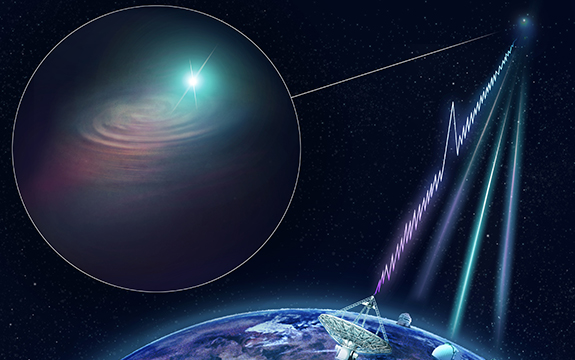
Artist’s impression of CSIRO’s Australian SKA Pathfinder radio telescope finding a fast radio burst and determining its precise location. Credit: CSIRO/Dr Andrew Howells
In a world first, an Australian-led, international team of astronomers has determined the precise location of a powerful one-off burst of cosmic radio waves known as ‘fast radio bursts’.
The discovery was made by a team, including Swinburne astrophysicists Dr Adam Deller and Dr Ryan Shannon, using CSIRO’s new Australian Square Kilometre Array Pathfinder (ASKAP) radio telescope in the Western Australian outback.
The galaxy from which the burst originated was imaged by three of the world’s largest optical telescopes, with the results published online in today.
A big breakthrough
“This is the big breakthrough that the field has been waiting for since astronomers discovered fast radio bursts in 2007,” says CSIRO lead author Dr Keith Bannister.
In the 12 years since then, a global hunt has netted 85 of these bursts. Most have been ‘one-offs’, but a small fraction are ‘repeaters’ that recur in the same location.
Fast radio bursts last less than a millisecond, making it difficult to accurately determine where they come from.
In 2017, astronomers found a repeater’s home galaxy. However, localising a one-off burst has been much more challenging.
Dr Bannister’s team developed new technology to freeze and save data from the new CSIRO telescope less than a second after a burst arrives at the telescope.
This technology was used to pinpoint the origin of the fast radio burst, identified as the outskirts of a galaxy just smaller than the Milky Way, about 4 billion light-years away.
“If we were to stand on the Moon and look down at the Earth with this precision, we would be able to tell not only which city the burst came from, but which postcode – and even which city block,” says Dr Bannister.
The CSIRO telescope used is made up of multiple dish antennas. The burst had to travel a different distance to each dish, reaching them all at a slightly different time.
Swinburne astrophysicist and discovery team member, , says: “From these tiny time differences – just a fraction of a billionth of a second – we identified the burst’s home galaxy and even its exact starting point, 13,000 light-years out from the galaxy’s centre in the galactic suburbs.”








